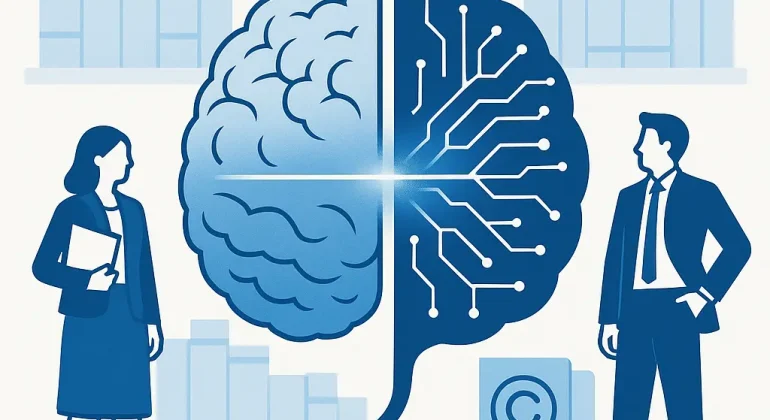With the rise of General-Purpose Artificial Intelligence (GPAI) models, copyright law is reaching a critical crossroads. The European Union is now striving to strike a balance between technological innovation and safeguarding the fundamental rights of creators. In this context, it has proposed a Code of Practice on AI, aimed at framing the use of GPAI in alignment with the forthcoming European AI Act. Published in March 2025, the third draft of this Code is intended to be more operational and addresses the concerns raised by rights holders.
Sommaire
What is a GPAI Model?
A General-Purpose Artificial Intelligence (GPAI) model is an AI system designed to perform a wide range of tasks, such as drafting texts, translating languages, analysing legal documents, or generating images. It is not restricted to a specific use, making it highly versatile.
To achieve such performance, a GPAI model must be trained on massive volumes of data drawn from the internet, books, scientific articles, forums, images, and audio content. This training relies on machine learning techniques that enable the model to detect patterns within the data, understand language, and even mimic styles.
This ability to leverage a broad array of content, often protected by copyright, raises complex legal questions, particularly with regard to the lawfulness of the use of online content. As a result, the establishment of a framework, notably through the GPAI Code of Practice, is essential to support the development of these technologies while safeguarding the rights of creators.
Understanding the third draft of the GPAI Code
Key objectives and structure of the text
The third draft of the GPAI Code pursues several key objectives:
- Enhancing transparency in the development and deployment of GPAI, through improved documentation of training data.
- Framing the use of copyrighted content by encouraging developers to assess the legality of their datasets and comply with EU copyright exceptions.
- Anticipating systemic risks by prompting providers to regularly evaluate the impacts of their GPAI models and adopt corrective measures.
The text adopts a modular structure, comprising general guidelines, documentation templates, technical recommendations, and frameworks for internal compliance policies.
Evolution from previous versions
The third draft represents a significant shift from earlier versions:
- Clarified and streamlined commitments, better adapted to industry operators.
- Standardised tools, such as “model cards,” to enhance transparency regarding the models’ features and datasets.
- A more flexible approach, transitioning certain obligations from mandatory requirements to recommended best practices.
Copyright challenges in the age of artificial intelligence
The impact of GPAI models on protected works
The training of GPAI models relies on extensive datasets of textual, visual, and audio materials, a significant portion of which is protected by copyright. This gives rise to several major concerns :
- Unauthorised use of protected works, without licenses or compliance with legal exceptions.
- Creation of derivative content closely imitating existing works, without acknowledgment or compensation to the original authors.
- Loss of authorship traceability, as models generate content disconnected from any identifiable source.
Legal grey areas
Several legal uncertainties remain:
- Resorting to data mining (TDM) exceptions, particularly for commercial GPAI models, remains subject to debate.
- Cross-border issues, especially where data is collected from jurisdictions with weaker copyright protections.
- The opacity of training processes, which hampers the ability of rights holders to detect and address infringements.
How the third draft addresses copyright issues
Transparency and data traceability
The GPAI Code of Practice promotes a culture of accountability through documentation:
- Standardised documentation templates enabling developers to describe the sources, types of data used, and legal justifications for their inclusion.
- Recommended publication of data summaries, to enhance clarity and accessibility for regulators and third parties.
Commitments from GPAI Providers
The draft favours a flexible yet structured approach:
- Publication of a copyright compliance policy: while optional, it is strongly encouraged.
- Dialogue with rights holders: the Code suggests establishing reporting channels, without imposing an obligation to respond or act immediately.
Reception of the draft by stakeholders
The third draft has prompted contrasting reactions:
- Some creators’ representatives view the draft as overly permissive, fearing a purely symbolic regulation without real enforcement mechanisms.
- GPAI providers, on the other hand, welcome a more pragmatic and operationally realistic version, although they still call for greater legal certainty.
Conclusion
The third draft of the EU GPAI Code represents a significant milestone in the regulation of general-purpose artificial intelligence models, fostering a culture of transparency and encouraging respect for copyright. Nevertheless, by relying mainly on voluntary commitments, its impact on industry practices may remain limited without binding obligations.
Key Takeaways:
- The third draft emphasises transparency through documentation, without imposing strict obligations.
- The use of protected works remains loosely regulated, particularly for commercial GPAI.
- A balanced approach between fostering innovation and protecting creators’ rights still needs to be achieved.
Need expert guidance on AI and intellectual property? Dreyfus Law Firm specializes in intellectual property law, including trademark, copyright, and AI-related legal matters.
We collaborate with a global network of intellectual property attorneys.
Join us on social media!

